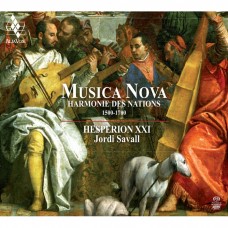新音樂: 和諧的國家(1500-1700歐洲各國宮廷音樂 ) 約第.沙瓦爾 指揮 晚星21古樂團 / Jordi Savall, Hesperion XXI / Musica Nova / Harmony of Nations
|
Perhaps it all goes back to one dark winter's night of the incipient and hope-filled year of 1400, at the dawn of a century that had just begun. A century which was soon to unravel the marvellous stories and odysseys of a newly rediscovered millennial civilization, an ancient era when philosophers taught wisdom and humanity, when the music of Orpheus could tame even the most savage of beasts. In the midst of so many novelties and marvels, it is no wonder that minstrels aspired to a new, more expressive and richer sound, to create a musica nova, or a new music, that came from a single instrument combining the love song of the old vihuela de arco or bowed fiddle, the rebab or troubadour's rebec, and the sweet sounds of the Moorish lute, with its potential for beautiful harmonies and joyful rhythms, which gave way to the vihuela de mano in the wake of the successive expulsions of the Jews in 1492 and the Moriscos in 1609.
|
編號 |
曲目 |
長度 |
作詞 |
作曲 |
演奏 |
樂團 |
演唱 |
指揮 |
試聽 |
|---|


